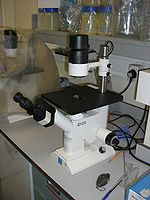Inverted microscope


An inverted microscope is a microscope with its light source and condenser on the top, above the stage pointing down, while the objectives and turret are below the stage pointing up. It was invented in 1850 by J. Lawrence Smith, a faculty member of Tulane University (then named the Medical College of Louisiana). [1]
Inverted microscopes are useful for observing living cells or organisms at the bottom of a large container (e.g. a tissue culture flask) under more natural conditions than on a glass slide, as is the case with a conventional microscope.
New models of inverted microscopes include the light source internal to the microscope housing while the viewing or recording optics are still below the sample location. The benefit of a light source below or parallel to the viewing area is that you may place samples directly on top of your microscope in a wide variety of geometry.
Inverted video microscopes scan and record the sample as digital or analog data. A video microscope may store data directly on a hard disc or in a buffer that requires a trigger or user intervention to store data.
Inverted microscopes with remote control capability are ideal for laboratory automation. They are typically configured into laboratories requiring fast analysis or controlled, sterile environments. Inputs and outputs allow researchers to automate sample analysis. Motorized focus, and X/Y traverse or optical zoom are examples of elements typically operated with remote capability. Using the digital inputs or outputs typical research involves synchronizing digital controllers, pulse generators, interloc switches, sensors or other devices. Remote operation is also handy for forensics laboratories, clean-room projects, or elements requiring special handling or storage conditions.
References
- ^ Smith JL (1852). "The inverted microscope-a new form of microscope". Am J Sci Arts. 14: 233–241.
